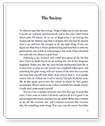Essay Instructions: Prepare a report by answering the following questions based on the case study below: ?Broken Windows, Damaged Gutters, and Police Supervision?.
Case Study: ?Broken Windows, Damaged Gutters, and Police Supervision?
Officer Mike Strzykalski was a ten-year veteran of the police department of Merrysville, a city of 500,000 people. The department had more than 2,000 police officers and a reputation of ?no-nonsense? policing, an attitude instilled by a former police chief who believed that the central purpose of the department was to ?catch the bad guys and throw them in the can.? Officer Strzykalski, known as ?Big Mike,? was an early supporter of this approach to policing and was respected by many of his peers. He knew that effective law enforcement meant identifying the bad element in the community and dealing with them directly and forcefully. More contemporary approaches to policing, such as community policing ideas and practices, were ?bullshit? and coddling criminals, as far as he was concerned. For Officer Strzykalski, policing meant making arrests and showing numbers. He learned early on in his career that getting the numbers was everything, and he also knew that it looked favorable for him at promotion time if he could show that he was productive. Officer Strzykalski, however, was to see all this change with the hiring of a new chief from outside the department. Chief Harold Furman, a progressive police professional, believed that the quality of policing was tied to how the department resolved community problems. He also knew that his ideas were foreign to this rather conservative community, yet he had the full support of the mayor in trying to bring the department into the 21st century. For Chief Furman, the little things were what mattered. He operationalized his philosophy of policing similar to the ideas of former New York City police commissioner William Bratton. Bratton had adopted an idea postulated by some Ivy League types that the erosion of quality of life in a community led toward urban decay and ultimately unchecked crime. Bratton boasted, both within police circles and among city politicians and the citizenry that attending to community concerns had caused a significant decrease in crime during the early 1990s. For Bratton and Furman, effective policing meant dealing with the little things in the community, from assisting
communities in cleaning up their neighborhoods to arresting individuals who were negligent in paying their tickets and municipal fines. With these principles in mind, Chief Furman restructured the Merrysville police department with a greater emphasis on community policing principles. His most drastic change came in the structure and deployment of police resources, specifically patrol officers. He contracted with the local Boys and Girls Clubs to rent space for police ministations where officers were close to their respective communities. He required precinct captains to have weekly meetings with neighborhood watch groups about problems in their communities. He solicited business and landlord support for removing drug houses from the most crime-infested areas of the city, and he worked with other city officials to provide more direct services to the community, such as more flexible hours for the health department to screen inner-city children for diseases prior to the beginning of the school year. To this end, he even tried to get police officers to offer ride-along for underprivileged parents and their children to the health department. He fought with the police union about this issue and ultimately lost in court; nevertheless, he proposed radical changes in the way the department responded to crime. For Officer Strzykalski and other veteran officers, these changes were too drastic and ineffectual. In Big Mike?s mind, the most significant change in the department under Chief Furman was the way street officers were evaluated by the department. Under the old system, numbers of arrests, field interrogations, and tickets were the primary ways in which officers were evaluated. The old system of employee evaluation was individually based and culminated in six-month performance appraisals of each officer (evaluations that most officers knew were worthless, but they made the bosses happy). Under the new system, officers had to attend to things that most seasoned
officers, including Officer Strzykalski, viewed as a waste of time. Contacts with citizens were not only encouraged but were mandated, along with the nature of the contact; if a problem was presented to the officer, he or she had to offer a potential solution that was documented in a daily log. In addition, officers were required to keep tabs of ?quality of life? measures on their beats. Noting such things as graffiti, gang activity, unkept public places, run-down apartments, and the number of absentee landlords, to mention a few, were critical activities for the police officer. The purpose of these efforts was to get a feel for the ?pulse of the community and its problems,? according to the official communication from the chief?s office. Officer Strzykalski hated these ideas and thought they removed the police from their real job: catching crooks. He could not see how these efforts were tied to ?real? crime. Like other officers, he accepted the new mandate reluctantly; however, he chose to fight what he considered to be the most ill-conceived idea: to alter performance evaluations from being individually based to group-based. He and other officers?for the first time?were being evaluated as a team as to how well they improved the quality of life among residents within their respective districts. What Officer Strzykalski particularly disliked was not being able to see how his performance was going to be individually evaluated and separated from that of other officers and, more important, how these evaluations were going to be used in the promotion process. At the same time Merrysville police supervisors, such as captains, lieutenants, and sergeants, were told to loosen up their commands and interact with officers, soliciting their support in the identification of crime spots and community problems. Supervisors were also told to seek advice from officers about the most effective ways to handle problems in their communities. The officers, in effect, were the experts. The supervisors served as support and liaison between the officers and higher-ups in the department as well as a conduit to various community groups. Initially, experienced officers such as Strzykalski were opposed to this new philosophy of policing, and some even tried to sabotage it by getting the union involved, arguing that the practices were in violation of the labor agreement between the city and the officers? union. This form of objection and protest was short lived, and most officers made adjustments in their behaviors when they could see that this new philosophy was actually in their best interests and gave them a greater say in how they performed their jobs. After the initial period of confusion and distrust had settled, both supervisors and police officers started to see the philosophy work in action. For Officer Strzykalski, the turning point was gutters and broken windows. On routine patrol, Officer Strzykalski had noticed that a number of garages in his district had their gutters removed and windows broken. He stopped by one resident who was repairing his garage window to ask how the window had gotten broken. He learned that there was a gang of ?young hoodlums? who were vandalizing garages as an initiation rite into a more established gang. The citizen viewed his garage as a casualty of this gang rite. Officer Strzykalski asked if this was common and if he knew of any other citizens who had their garages vandalized in a similar fashion. The citizen responded that he knew of at least four other garages that had been vandalized in the last week. Seeing this as an opportunity to impress his superiors, Officer Strzykalski was able to obtain the names and addresses of other citizens in the district who had their garages vandalized in the last three months. He collected over twenty names and addresses. With this information, he organized, with approval from his sergeant and lieutenant, times when he could meet with each victim and the group as a whole. The supervisory staff viewed Officer Strzykalski?s efforts as innovative and consistent with the new mission of the department: crime reduction through community involvement. After three months, Officer Strzykalski had not only assisted the citizens in protecting their properties more effectively, but also had been able to gather intelligence information on gang activity and feed this information back to the gang squad to help in their efforts to suppress gang-related crimes. After one year, Officer Strzykalski?s work was singled out by the department as an example of effective community policing. Chief Furman commended him and other officers at a formal awards banquet. For Officer Strzykalski, the most important insight was that working with the community was not only a better form of policing, but one that was personally rewarding and satisfying. For three months straight, officers in his district were commended by the police administration and various community groups for their efforts to address community problems. A promotion followed shortly thereafter. As a sergeant, Strzykalski viewed his role as a facilitator for the rank-and-file officers. He felt this supervision style allowed him to empower officers to address the problems most significant to the community. Moreover, of officers felt that they were more part of a solution rather than a problem, as well as a team committed to the improvement of their district. Sergeant Strzykalski could only reminisce about the old days in the department: too many quotas, too much in-fighting and very ineffective policing. He thought how the change in the department opened his eyes to doing something different, something he would not have ever dreamed of one year earlier. He reflected how change for him was predicated on broken windows and damaged gutters. He kept these recollections as a reminder of how policing, especially police supervision, was and what it had become. He dedicated himself to never returning to the ineffective ways of policing because, in his words, ?they never really accomplished anything, either for the citizen or the cop.?
Case Study Questions
1. What are some primary obstacles police reformers face when trying to implement a community policing philosophy within a police department? What issues of police supervision are the most important in making a switch from a traditional police organization to one structured by the principles of community policing?
2. Would many patrol officers embrace the model of supervision emphasized by
community policing? Why or why not? What about frontline supervisors, such as sergeants? What difficulties would they have supervising officers under a community policing approach?
3. Is Officer/Sergeant Strzykalski too idealistic about police supervision in this case study? Why or why not? What can police supervisors do to address the fears of patrol officers about community policing ideas and practices?
Criminal Justice Organizations
Stan Stojkovic, David Kalinich, John Klofas
Copyright 2003 Wadsworth / Thomson


